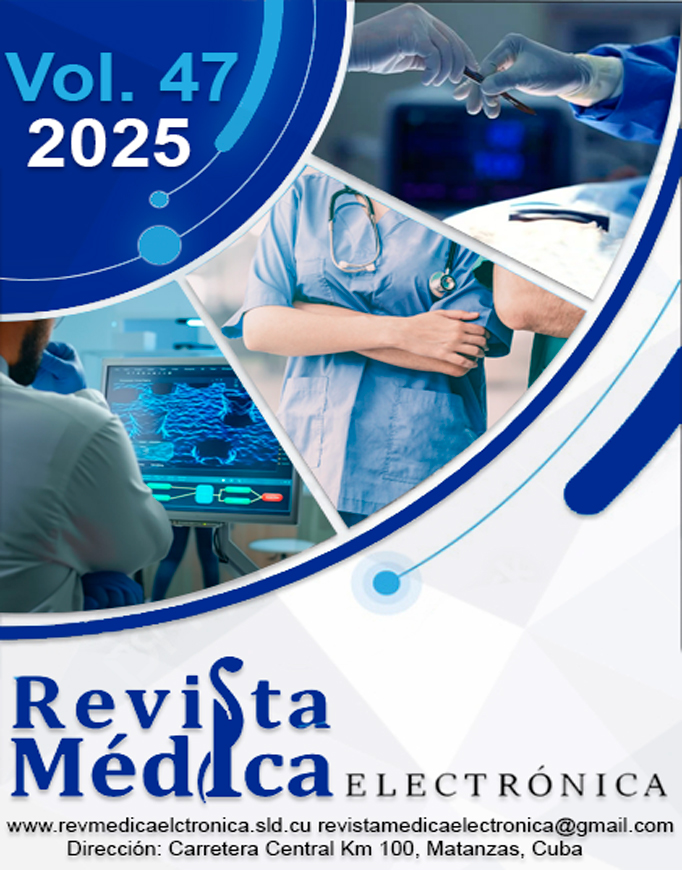Effects of strength/endurance training on functional and biochemical capacity in older adults
Keywords:
strength/endurance, functional capacity, biochemical capacity, older adultAbstract
Introduction: Positive changes in the physical, functional, and metabolic health of older adults involve the implementation of a physical stimulation program, which involves the improvement of muscular strength and cardiovascular endurance.
Objective: To improve functional capacity and biochemical parameters in older adults through a strength/endurance training program tailored to their needs.
Methods: Descriptive/explanatory correlational research studying a sample of older adults (n=35; 63-70 years) participating in an intervention program with strength/endurance stimuli (12 weeks, 5 phases). The effects on functional and biochemical indicators were assessed.
Results: Functionally, hand grip strength (+20.5%), lower limb strength/endurance (+37.8%), aerobic endurance (+15.9%), balance (+51.2%), as well as mobility and the risk of falls (-22.2%) improved. Biochemically, indicators such as blood glucose (-5.3), pH (+0.2), cholesterol (-15.4), chronic inflammation (-48.6%), and lactate stored in blood (-0.6) improved. All tests were significantly different in favor of the post-test (p<0.05).
Conclusions: The adapted strength/endurance program has significant positive effects on biochemical and functional capacity parameters. Improvements in glucose, cholesterol, lactate, and pH reflect the metabolic benefits of exercise, while improvements in strength, endurance, mobility, and balance indicate a positive impact on functional health. There is a need to promote physical exercise among older adults to improve their overall health and quality of life.
Downloads
References
1. Torralbo HG, Guizardi M, Nazal E. Antropología y envejecimiento: Guía de lecturas para la formación académica. Santiago de Chile: Canopus Editorial Digital SA; 2024.
2. Alodhialah AM, Almutairi AA, Almutairi M. Physical Inactivity and Cardiovascular Health in Aging Populations: Epidemiological Evidence and Policy Implications from Riyadh, Saudi Arabia. Life. 2025;15(3):347. DOI: 10.3390/life15030347.
3. Calero Morales S, Maldonado Velasco IM, Fernández Lorenzo A, et al. Actividades físico-recreativas para disminuir la obesidad en mujeres entre los 35-50 años de edad. Rev Cubana Invest Bioméd [Internet]. 2016 [citado 03/03/2025];35(4):375-86. Disponible en: http://scielo.sld.cu/scielo.php?pid=S0864-03002016000400008&script=sci_arttext&tlng=en
4. Alomoto Mera M, Calero Morales S, Vaca García MR. Intervención con actividad físico-recreativa para la ansiedad y la depresión en el adulto mayor. Rev Cubana Inv Bioméd [Internet]. 2018 [citado 03/03/2025];37(1). Disponible en: http://www.revibiomedica.sld.cu/index.php/ibi/article/view/95
5. Salazar Quinatoa M, Calero Morales S. Influencia de la actividad física en la motricidad fina y gruesa del adulto mayor femenino. Rev Cubana Inv Bioméd [Internet]. 2018 [citado 03/03/2025];37(3). Disponible en: http://www.revibiomedica.sld.cu/index.php/ibi/article/view/127/html
6. Airasca DA, Giardini HA. Actividad física, salud y bienestar. Buenos Aires: Nobuko; 2022.
7. Moya Ortega M, Villa Gil JM, Moya Ortega A, et al. Efectos del entrenamiento de fuerza con restricción del flujo sanguíneo en personas con sarcopenia: una revisión narrativa. Rev Iberoam Cienc Act Fís Deporte. 2024;13(3):180-94. DOI: 10.24310/riccafd.13.3.2024.20319.
8. Enríquez Canto Y, Pizarro Andrade R, Ugarriza Rodríguez L. Ejercicios multicomponente sobre la calidad de vida y el equilibrio en adultos mayores: Revisión sistemática y metaanálisis. Fisioterapia. 2022;44(6):360-70. DOI: 10.1016/j.ft.2021.12.003.
9. Zequeira-García B. La actividad física como reductora de riesgo cardiovascular en personas hipertensas. Rev Méd Electrón [Internet]. 2023 [citado 03/03/2025];45(6):1038-43. Disponible en: http://scielo.sld.cu/scielo.php?pid=S1684-18242023000601038&script=sci_arttext&tlng=pt
10. Morales Paredes AN, Rivarola Monzon DG, Romero Mansilla M, et al. Actividad física en el hogar para mejorar la fuerza y equilibrio en el adulto mayor para prevenir el riesgo de caídas. Revisión Bibliográfica. Retos. 2024;53. DOI: 10.47197/retos.v53.99567.
11. Hermosilla Palma FA, Castelli de Campos LF, Cossio Bolaños M, et al. Índice de Masa Corporal, Velocidad de Marcha y Fuerza de Prensión Manual en Mujeres Mayores Chilenas. Retos. 2022;43:135-42. DOI: 10.47197/retos.v43i0.88743.
12. Mainer-Pardos E, Villavicencio Álvarez VE, Moreno-Apellaniz N, et al. Effects of a neuromuscular training program on the performance and inter-limb asymmetries in highly trained junior male tennis players. Heliyon. 2024;10(5):e27081. DOI: 10.1016/j.heliyon.2024.e27081.
13. Mon D, Zakynthinaki MS, Calero S. Connection between performance and body sway/morphology in juvenile Olympic shooters. J hum sport exerc. 2019;14(1):75-85. DOI: 10.14198/jhse.2019.141.06.
14. Mon-López D, Moreira da Silva F, Calero-Morales S, et al. What Do Olympic Shooters Think about Physical Training Factors and Their Performance? Int J Environ Res Public Health [Internet]. 2019 [citado 03/03/2025];16(23):4629. Disponible en: https://pubmed.ncbi.nlm.nih.gov/31766408/
15. Moreno-Apellaniz N, Villanueva-Guerrero O, Villavicencio-Álvarez VE, et al. Impact of Lower-Limb Asymmetries on Physical Performance Among Adolescent Female Tennis Players. Life. 2024;14(12):1561. DOI: 10.3390/life14121561.
16. Roso-Moliner A, Gonzalo-Skok O, Villavicencio-Álvarez VE, et al. Analyzing the Influence of Speed and Jumping Performance Metrics on Percentage Change of Direction Deficit in Adolescent Female Soccer Players. Life. 2024;14(4):466. DOI: 10.3390/life14040466.
17. Muscella A, Stefàno E, Marsigliante S. The effects of exercise training on lipid metabolism and coronary heart disease. Am J Physiol Heart Circ Physiol. 2020;319(1):H76-88. DOI: 10.1152/ajpheart.00708.2019.
18. Thyfault JP, Bergouignan A. Exercise and metabolic health: beyond skeletal muscle. Diabetologia. 2020;63:1464-74. DOI: 10.1007/s00125-020-05177-6.
19. Merellano-Navarro E, Olate-Briones A, Norambuena-Mardones L, et al. Un número reducido de células t vírgenes se correlaciona con un aumento de la inflamación sistémica de bajo grado durante el envejecimiento y puede ser modulado por la actividad física. Int J Morphol. 2021;39(3):89-96. DOI: 10.4067/S0717-95022021000300789.
20. Ángel Vázquez L, Navarro Patón R, Ramos Álvarez O, et al. Actividad física y calidad de vida de adultos mayores en Argentina: un estudio transversal. Retos. 2023;48:86-93. DOI: 10.47197/retos.v48.93321.
21. Kleinke F, Penndorf P, Ulbricht S, et al. Levels of and determinants for physical activity and physical inactivity in a group of healthy elderly people in Germany: Baseline results of the MOVING-study. PloS One. 2020;15(8):e0237495. DOI: 10.1371/journal.pone.0237495.
22. Calero Morales S, Klever Díaz T, Caiza Cumbajin MR, et al. Influencia de las actividades físico-recreativas en la autoestima del adulto mayor. Rev Cubana Invest Bioméd [Internet]. 2016 [citado 03/03/2025];35(4):366-74. Disponible en: http://scielo.sld.cu/scielo.php?pid=S0864-03002016000400007&script=sci_arttext&tlng=pt
23. Grgic J, Garofolini A, Orazem J, et al. Effects of resistance training on muscle size and strength in very elderly adults: a systematic review and meta-analysis of randomized controlled trials. Sports Med. 2020;50:1983-99. DOI: 10.1007/s40279-020-01331-7.
24. Lu L, Mao L, Feng Y, et al. Effects of different exercise training modes on muscle strength and physical performance in older people with sarcopenia: a systematic review and meta-analysis. BMC Geriatr. 2021;21:708. DOI: 10.1186/s12877-021-02642-8.
25. Sevil M, Rashid M, Hajizadeh I, et al. Physical activity and psychological stress detection and assessment of their effects on glucose concentration predictions in diabetes management. IEEE Trans Biomed Eng. 2021;68(7):2251-60. DOI: 10.1109/TBME.2020.3049109.
26. Lombardi G, Ziemann E, Banfi G, et al. Physical activity-dependent regulation of parathyroid hormone and calcium-phosphorous metabolism. Int J Mol Sci. 2020;21(15):5388. DOI: 10.3390/ijms21155388.
27. Quispe R, Martin SS, Michos ED, et al. Remnant cholesterol predicts cardiovascular disease beyond LDL and ApoB: a primary prevention study. Eur Heart J. 2021;42(42):4324-32. DOI: 10.1093/eurheartj/ehab432.
28. Brito Vásquez VE, Granizo Riquetti HA, Calero Morales S, et al. Estudio del ácido láctico en el crossfit: Aplicación en cuatro sesiones de entrenamiento. Rev Cubana Inv Bioméd [Internet]. 2017 [citado 03/03/2025];36(3). Disponible en: http://www.revibiomedica.sld.cu/index.php/ibi/article/view/73
29. Görünmezoğlu C, Çinar Özdemir Ö, Barğı G, et al. Effectiveness of Inspiratory Muscle Training in Individuals with Chronic Venous Disease: A Randomized Controlled Study. Life. 2025;15(2):296. DOI: 10.3390/life15020296.
30. Rodríguez Ángel F, Páez Granja RE, Altamirano Vaca EJ, et al. Nuevas perspectivas educativas orientadas a la promoción de la salud. Educ Méd Super [Internet]. 2017 [citado 03/03/2025];31(4). Disponible en: https://ems.sld.cu/index.php/ems/article/view/1366
Downloads
Published
How to Cite
Issue
Section
License
Copyright (c) 2025 Mónica Lilián Andrade-Avalos, Hugo Santiago Trujillo-Chávez, Evelyn Carolina Macias-Silva, Nelly Ivonne Guananga-Díaz

This work is licensed under a Creative Commons Attribution-NonCommercial 4.0 International License.
All content published in this journal is Open Access, distributed under the terms of the CC BY-NC 4.0 License.
It allows:
- Copy and redistribute published material in any medium or format.
- Adapt the content.
This will be done under the following terms:
- Attribute the authors' credits and indicate whether changes were made, in which case it must be in a reasonable way.
- Non-commercial use.
- Recognize the journal where it is published.
The copyrights of each article are maintained, without restrictions.






